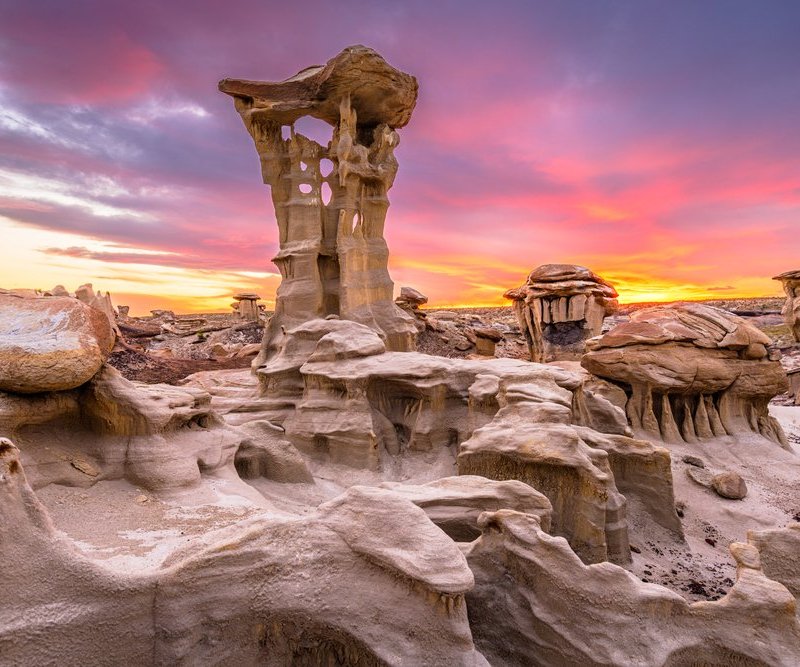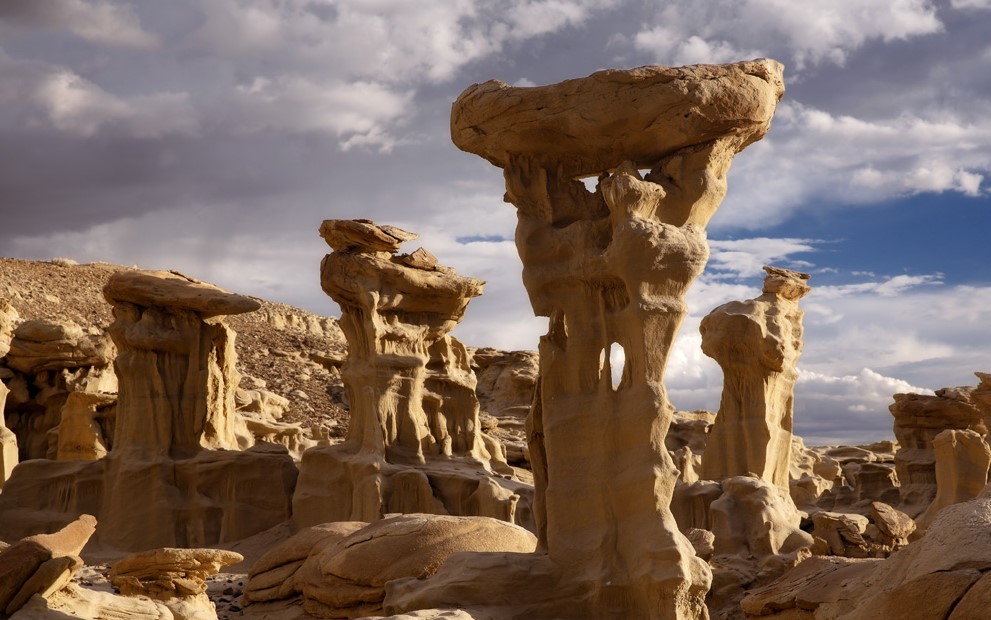
Note: The Travel Awaits team regularly updates content to provide the latest, and most accurate information to our readers. The updated content in this article may not reflect the views or opinions of the original author.
Alien Throne sure looks alien. Its columns and their connections, don’t quite make sense. Its openings are irregular, its presence imposing and odd-even among several odd, imposing sights. There appears to be a plan to it, but not our plan.
This incredible rock formation is a couple of degrees off from looking natural, a couple of degrees off from looking man-made. But it’s something, that’s for sure.

What is Alien Throne, New Mexico?
Alien Throne is a hoodoo. They’re formed by erosive forces like wind, rain, and flowing water beating away at stacked layers of soft and hard rock. The softer layers wear down relatively quickly, but the harder layers resist for longer — eventually, we’re left with impossible shapes. Hoodoos tend to have hard “cap rocks” on top, which protect the soft layers, and alien features, below.
Due to their unique upbringings and mineral makeup, all hoodoos look different. The home to various critters and wild horses, Alien Throne looks like a pile of tan Nesquik wind-whipped into sturdy, impossible permanence. Yet its permanence arises from respect; it also looks like a careless giant could squeeze it into a puff of dust. It hasn’t, though, so why would we?

The Earth, unfortunately, is already aggressive enough. Erosive forces don’t stop when the structures look satisfactorily alien — hoodoos aren’t finished until they’re finished. Wind and water take feet of size from them every century. To avoid expediting their return to dust, experts recommend staying away from hoodoos’ bases, as that can prevent unnecessary erosion. And if one looks precarious (as the best hoodoos tend to) stay away from it rather than testing its strength. That’s good for everybody.
Where is Alien Throne?
Alien Throne stands in the Valley of Dreams, a remote field of hoodoos in the San Juan Basin in New Mexico, on Navajo Nation land in the northwestern New Mexico badlands. It’s filled with petrified wood — even petrified trunks and branches — and is rich with fossils. It’s just outside the Ah-Shi-Sle-Pah Wilderness, where paleontologists discovered not the Triceratops, but the Pentaceratops. Five horns instead of three. Again, just a couple of degrees off.

It’s near Chaco Culture National Historical Park, which hosts an ancient, immense Pueblo village with a strikingly well-preserved ceremonial center. A nine-mile driving loop will take you past most of the notable sights, and guided tours are also available.
Albuquerque is two and a half hours to the southeast. To get to Valley of Dreams from there, you need to take US-550 north, then dirt roads.

What Should I Know About Going to Alien Throne?
Getting to the Valley of Dreams, and thus the Alien Throne, is not easy. It’s in a remote area with no roads (or signs, or official trails) leading directly to it. The dusty, rocky terrain can be difficult for travelers with mobility limitations, and there are no bathrooms nearby.
If you do want to make the 3.7-mile roundtrip hike in the Navajo Nation land, known as the Valley of Dreams Loop, it’s best to do it during the daytime (with plenty of water) during summer or fall. If you’re an experienced hiker and plan to go at night for some astrophotography, bring a powerful flashlight and download a GPS app like AllTrails that can bring you back to your starting point.
Most importantly, be respectful of the land and the structures. The giant hasn’t crushed it into dust, and we shouldn’t either. You also might see cows and horses grazing the area — they’re owned by Navajo farmers and should be admired from afar but not disturbed. Take nothing, and leave nothing.
Hikes Near the Valley of Dreams
King of Wings is one of the nearby trails to explore. You can continue hiking past Valley of Dreams to just hike to the King of Wings, or you can opt to drive around instead of hiking back.
There is also an area very similar to Valley of Dreams that has been named Valley of Dreams East which has a similar look to Valley of Dreams, but without the Alien Throne.
Also close to this part of New Mexico is the Chaco Culture National Historical Park in Chaco Canyon which can easily be added to your badlands itinerary.

Where to Stay Near the Valley of Dreams?
There are plenty of hotels near Valley of Dreams Trailhead in San Juan County. The best destination to stay and to begin exploring this part of New Mexico Badlands is probably Farmington. When you are in the area, one of the best places to stay is at the Home2 Suites by Hilton in Farmington.
If you are taking a day trip from Albuquerque, the Hyatt Regency Tamaya Resort and Spa is a great spot for a weekend getaway. With lots of activities and great restaurants on-site, you’d love it.
FAQs
How Was Alien Throne Formed?
Alien Throne is one of the impressive rock formations carved by wind and water. The famous landmark is located at the north end of the Valley of Dreams in the New Mexico badlands near the Ah-Shi-Sle-Pah Wilderness.
What Does Ah-Shi-Sle-Pah Mean?
Ah-Shi-Sle-Pah means ‘‘gray salt’’. It is a badlands area and a federal wilderness study area that offers some of the most unusual scenery in the Four Corners where the erosion has etched a fantasy world of strange rock formations. It is located in San Juan County, New Mexico.
Are There Other Things to See on the Valley of Dreams Hike?
Once you find Alien Throne, you can try to find other rock formations on the marked trails on the rolling clay hills. Giant Mushroom, the Milky Way, Chocolate Penguin King, Petrified Wood Turtle, and Red Dinosaur Egg are just some of the popular rock formations.
What Is the Valley of Dreams?
Covering over 6,500 acres in total, the suitably named Valley of Dreams is one of several hiking areas within the larger Ah-Shi-Sle-Pah Wilderness Area Similar to Bisti Badlands, it is managed by the Bureau of Land Management, which means they’re free to enter and camp.
How to Get To Valley of Dreams
Valley of Dreams is near Chaco Culture National Historical Park, about 70 miles from Farmington and 90 miles from Shiprock Formation. From Albuquerque, it takes at least 3 hours of driving and from the historic city of Santa Fe, it is at least 3 hours of driving via US-550 N.
